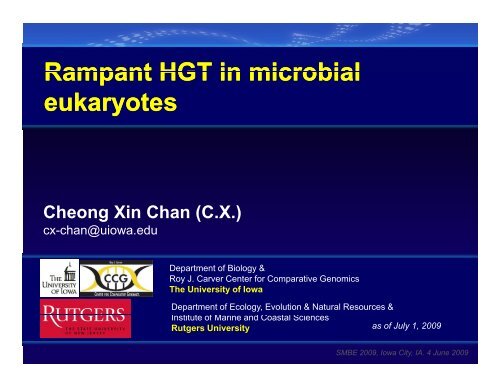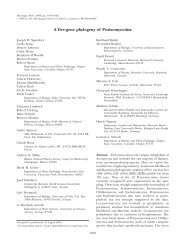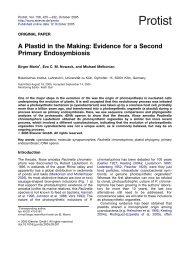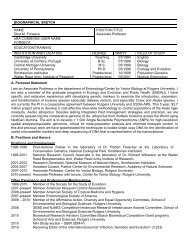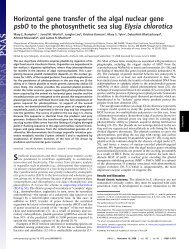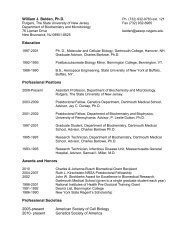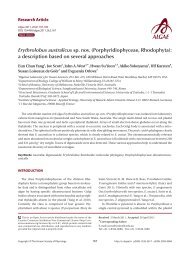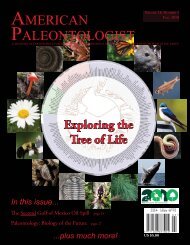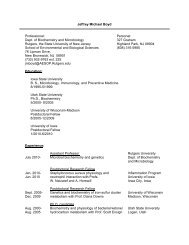Rampant HGT in microbial Rampant HGT in microbial eukaryotes
Rampant HGT in microbial Rampant HGT in microbial eukaryotes
Rampant HGT in microbial Rampant HGT in microbial eukaryotes
- No tags were found...
You also want an ePaper? Increase the reach of your titles
YUMPU automatically turns print PDFs into web optimized ePapers that Google loves.
<strong>Rampant</strong> <strong>HGT</strong> <strong>in</strong> <strong>microbial</strong><strong>eukaryotes</strong>Cheong X<strong>in</strong> Chan (C.X.)cx-chan@uiowa.eduDepartment t of Biology &Roy J. Carver Center for Comparative GenomicsThe University of IowaDepartment of Ecology, Evolution & Natural Resources &Institute t of Mar<strong>in</strong>e and Coastal SciencesRutgers University as of July 1, 2009SMBE 2009, Iowa City, IA. 4 June 2009
IntroductionHorizontal gene transfer (<strong>HGT</strong>)Doolittle WF(1999). Science284: 2124-2128.Transfer of genetic materials between non-l<strong>in</strong>eal organisms2
1992 PNAS, 89: 8990-42005 PNAS, 102: 14332-72007 Science, 317: 1753-62008PNAS, 105: 17867-712009MBE, 26: 367-743
IntroductionEndosymbiosis Endosymbiotic gene & evolution transfer of (EGT)<strong>eukaryotes</strong>Secondary EGTPrimaryEGT4
Objectives<strong>HGT</strong> <strong>in</strong> <strong>microbial</strong> <strong>eukaryotes</strong>• To exam<strong>in</strong>e the gene orig<strong>in</strong>s, i.e., extent of<strong>HGT</strong>/EGT <strong>in</strong> <strong>microbial</strong> <strong>eukaryotes</strong>• To exam<strong>in</strong>e the potential impact of <strong>HGT</strong>/EGT<strong>in</strong> these organisms on the reconstruction ofthe eukaryote tree of life5
EGT & <strong>HGT</strong> <strong>in</strong> D<strong>in</strong>oflagellates- Involvement of tertiary endosymbiosis(Yoon et al., 2005, MBE; Nosenko et al., 2006, MBE)- Tertiary EGT(e.g., eukaryote-eukaryote gene transfer)- EGT & <strong>HGT</strong>: key contributors to the genomemake-up- Genes are expected to have a variety ofevolutionary histories (to have come fromvarious sources of other l<strong>in</strong>eages)- Genomes are expected to be highly chimeric7
D<strong>in</strong>oflagellatesAlexandrium tamarensehttp://www.whoi.edu/science/B/redtide/species/alexandrium_images.htmlhttp://www.whoi.edu/redtide/page.do?pid=24595http://serc.carleton.edu/images/microbelife/topics/red_tide_for_ed.jpghttp://www.whoi.edu/cms/images/5_47876.jpg- Heterotrophic primary mar<strong>in</strong>eproducers, perid<strong>in</strong><strong>in</strong>-conta<strong>in</strong><strong>in</strong>g- Each cell is ~25-46 µm <strong>in</strong> length- Causative agent of “red tide” (HAB)- Produces saxitox<strong>in</strong> (a neurotox<strong>in</strong>)- Causes paralytic shellfish h poison<strong>in</strong>gi(PSP)- Limited genomic data 8
MethodologyGenome make-up of d<strong>in</strong>oflagellatesAlexandrium tamarense ESTs(12,329)Phylogenomic pipel<strong>in</strong>eML & BayesianMoustafa*, Chan* et al., (2008). Genome Informatics 21: 165-176.9
Results & DiscussionGenome make-up of d<strong>in</strong>oflagellates• One-half of the genes <strong>in</strong> A. tamarense encode novelfunctions• A. tamarense genes have diverse taxonomic orig<strong>in</strong>s• Chromalveolates and Plantae are major partners ofgene shar<strong>in</strong>g <strong>in</strong> d<strong>in</strong>oflagellates• Most genes from Plantae are from the green algae• Novel observation of GT <strong>in</strong>stances (440) between thehaptophytes (Emiliania huxleyi) to perid<strong>in</strong><strong>in</strong>d<strong>in</strong>oflagellates• Transferred genes with variety of functions, prote<strong>in</strong>targets not limited to chloroplast and mitochondria11
Results & DiscussionGreen genes <strong>in</strong> d<strong>in</strong>oflagellateshttp://www.morn<strong>in</strong>g-earth.org/Micromonas pusilahttp://genome.jgi-psf.org/Ost9901_3/Ostta.jpgPras<strong>in</strong>ophytes- Anciently derived green algae,pico<strong>eukaryotes</strong>- Each cell is < 2 µm <strong>in</strong> length- Likely candidates for crypticendosymbionts- Genomes of Micromonas andOstreococcus have recentlybeen completely sequenced,provid<strong>in</strong>g a sizeable gene poolfor analysisOstreococcus12
fucoxanth<strong>in</strong> d<strong>in</strong>operid<strong>in</strong><strong>in</strong> d<strong>in</strong>oTertiaryendosymbiosis• 125 pras<strong>in</strong>ophyte-derived gene <strong>in</strong>d<strong>in</strong>oflagellates• Possible explanations:• (a) <strong>HGT</strong> from a pras<strong>in</strong>ophyte source, or• (b) massive gene loss <strong>in</strong> all other chromalveolatel<strong>in</strong>eages• Example also shows putative EGT betweenhaptophyte l<strong>in</strong>eage with the fucoxanth<strong>in</strong>d<strong>in</strong>oflagellates(as expected <strong>in</strong> tertiary endosymbiosis)13
Results & DiscussionHaptophyte-derived genes <strong>in</strong> d<strong>in</strong>oflagellates• 400+ haptophyte-derived genes <strong>in</strong> A.tamarense (a perid<strong>in</strong><strong>in</strong> d<strong>in</strong>oflagellate)• 382 from Emiliania huxleyi (of which completegenome is available)• These genes encode various transferases andother prote<strong>in</strong>s crucial to cellular processes15
perid<strong>in</strong><strong>in</strong> d<strong>in</strong>ofucoxanth<strong>in</strong> d<strong>in</strong>oSPDS gene family (spermid<strong>in</strong>e synthase)16
Results & DiscussionHaptophyte-derived genes <strong>in</strong> d<strong>in</strong>oflagellatesWhat does that tell us?• Another “hidden” endosymbiosis<strong>in</strong> chromalveolates l at the baseof d<strong>in</strong>oflagellates – these genesare <strong>in</strong>stances of EGT• Haptophytes are common preyfor early diverg<strong>in</strong>g perid<strong>in</strong><strong>in</strong>d<strong>in</strong>oflagellates – these genesare <strong>in</strong>stances of <strong>HGT</strong>17
Results & DiscussionEffects on <strong>in</strong>ferr<strong>in</strong>g the tree of life• At least 32.4% of the total ESTs <strong>in</strong> this study show<strong>HGT</strong> history• The number represents a conservative estimate• Limited by <strong>HGT</strong> detectibility and taxon sampl<strong>in</strong>g• 387 (3.1%) “<strong>in</strong>formational/structural” genes show noevidence of <strong>HGT</strong> – represent signals of vertical<strong>in</strong>heritance• Chimeric i genomes of <strong>microbial</strong> <strong>eukaryotes</strong>complicate the resolution of these l<strong>in</strong>eages on thetree of life18
Conclusions• <strong>HGT</strong> among <strong>microbial</strong> <strong>eukaryotes</strong> is comparable to thosereported <strong>in</strong> prokaryotes• Phylogenetic markers that are useful for del<strong>in</strong>eat<strong>in</strong>grelationships with<strong>in</strong> other groups might proved <strong>in</strong>appropriatewhen applied to d<strong>in</strong>oflagellates (and chromalveolates)• Higher cellular complexity & greater gene cod<strong>in</strong>g capacity <strong>in</strong><strong>microbial</strong> <strong>eukaryotes</strong> (compared to prokaryotes) do notconstitute significant barriers to <strong>HGT</strong>• <strong>HGT</strong> <strong>in</strong> <strong>microbial</strong> <strong>eukaryotes</strong> are rampant• Many of these organisms are found <strong>in</strong> harsh and highlyvariable aquatic environments – they acquire foreign genes torepair, replace or provide novel traits to adapt to chang<strong>in</strong>genvironmental conditions19
AcknowledgementsBhattacharya GroupDebashish BhattacharyaAhmed MoustafaAdrián Reyes-PrietoValérie ReebBill LanierHeather TyraJeferson GrossNIH grant R01ES013679SMBE 2009, Iowa City, IA. 4 June 200920. The End


